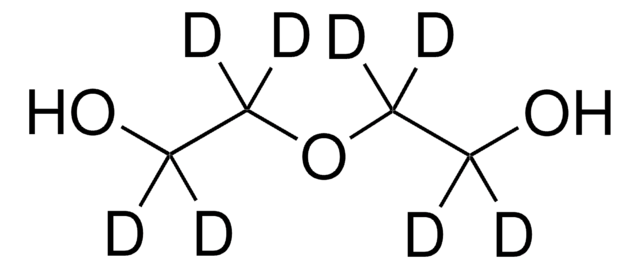If this product has an expiration or retest date, it will be shown on the Certificate of Analysis (COA, CofA). If there is no retest or expiration date listed on the product's COA, we do not have suitable stability data to determine a shelf life. For these products, the only date on the COA will be the release date; a retest, expiration, or use-by-date will not be displayed.
For all products, we recommend handling per defined conditions as printed in our product literature and website product descriptions. We recommend that products should be routinely inspected by customers to ensure they perform as expected.
For products without retest or expiration dates, our standard warranty of 1 year from the date of shipment is applicable.
For more information, please refer to the Product Dating Information document: https://www.sigmaaldrich.com/deepweb/assets/sigmaaldrich/marketing/global/documents/449/386/product-dating-information-mk.pdf
93171
Diethylene glycol
BioUltra, ≥99.0% (GC)
Sinónimos:
2,2′-Oxydiethanol, 2-Hydroxyethyl ether, Bis(2-hydroxyethyl) ether, Diglycol
Seleccione un Tamaño
55,50 €
Seleccione un Tamaño
About This Item
55,50 €
Productos recomendados
densidad de vapor
2.14 (vs air)
presión de vapor
0.01 mmHg ( 20 °C)
descripción
non-ionic
Línea del producto
BioUltra
Ensayo
≥99.0% (GC)
Formulario
liquid
viscous liquid
temp. de autoignición
442 °F
lim. expl.
2-12.3 %
impurezas
insoluble matter, passes filter test
≤30 mg/kg peroxides (as H2O2)
índice de refracción
n20/D 1.447 (lit.)
n20/D 1.447
pH
5.5-7.0 (25 °C, 50 mg/mL in H2O)
bp
245 °C (lit.)
mp
−10 °C (lit.)
solubilidad
H2O: 50 mg/mL at 20 °C, clear, colorless
densidad
1.118 g/mL at 25 °C (lit.)
trazas de anión
chloride (Cl-): ≤50 mg/kg
sulfate (SO42-): ≤50 mg/kg
trazas de catión
Al: ≤10 mg/kg
As: ≤0.1 mg/kg
Ba: ≤5 mg/kg
Bi: ≤5 mg/kg
Ca: ≤10 mg/kg
Cd: ≤5 mg/kg
Co: ≤5 mg/kg
Cr: ≤5 mg/kg
Cu: ≤5 mg/kg
Fe: ≤5 mg/kg
K: ≤200 mg/kg
Li: ≤5 mg/kg
Mg: ≤5 mg/kg
Mn: ≤5 mg/kg
Mo: ≤5 mg/kg
Na: ≤200 mg/kg
Ni: ≤5 mg/kg
Pb: ≤5 mg/kg
Sr: ≤5 mg/kg
Zn: ≤5 mg/kg
cadena SMILES
OCCOCCO
λ
50 mg/mL in H2O
Absorción UV
λ: 260 nm Amax: ≤0.060
λ: 280 nm Amax: ≤0.030
InChI
1S/C4H10O3/c5-1-3-7-4-2-6/h5-6H,1-4H2
Clave InChI
MTHSVFCYNBDYFN-UHFFFAOYSA-N
¿Está buscando productos similares? Visita Guía de comparación de productos
Aplicación
Palabra de señalización
Warning
Frases de peligro
Consejos de prudencia
Clasificaciones de peligro
Acute Tox. 4 Oral
Código de clase de almacenamiento
10 - Combustible liquids
Clase de riesgo para el agua (WGK)
WGK 1
Punto de inflamabilidad (°F)
280.4 °F - closed cup
Punto de inflamabilidad (°C)
138 °C - closed cup
Equipo de protección personal
Eyeshields, Faceshields, Gloves, type ABEK (EN14387) respirator filter
Elija entre una de las versiones más recientes:
Certificados de análisis (COA)
¿No ve la versión correcta?
Si necesita una versión concreta, puede buscar un certificado específico por el número de lote.
¿Ya tiene este producto?
Encuentre la documentación para los productos que ha comprado recientemente en la Biblioteca de documentos.
Los clientes también vieron
-
How can I determine the shelf life / expiration / retest date of this product?
1 respuesta-
¿Le ha resultado útil?
-
-
How is shipping temperature determined? And how is it related to the product storage temperature?
1 respuesta-
Products may be shipped at a different temperature than the recommended long-term storage temperature. If the product quality is sensitive to short-term exposure to conditions other than the recommended long-term storage, it will be shipped on wet or dry-ice. If the product quality is NOT affected by short-term exposure to conditions other than the recommended long-term storage, it will be shipped at ambient temperature. As shipping routes are configured for minimum transit times, shipping at ambient temperature helps control shipping costs for our customers. For more information, please refer to the Storage and Transport Conditions document: https://www.sigmaaldrich.com/deepweb/assets/sigmaaldrich/marketing/global/documents/316/622/storage-transport-conditions-mk.pdf
¿Le ha resultado útil?
-
Filtros activos
Nuestro equipo de científicos tiene experiencia en todas las áreas de investigación: Ciencias de la vida, Ciencia de los materiales, Síntesis química, Cromatografía, Analítica y muchas otras.
Póngase en contacto con el Servicio técnico








